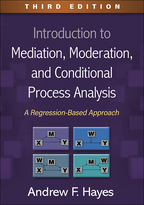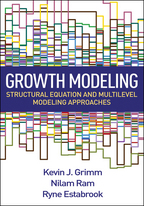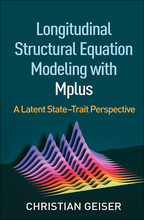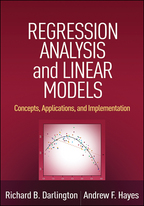Quasi-Experimentation
A Guide to Design and Analysis
Charles S. Reichardt

Overview
1.1 Introduction
1.2 The Definition of Quasi-Experiment
1.3 Why Study Quasi-Experiments
1.4 Overview of the Volume
1.5 Conclusions
1.6 Suggested Reading
2. Cause and Effect
Overview
2.1 Introduction
2.2 Practical Comparisons and Confounds
2.3 The Counterfactual Definition
2.4 The Stable-Unit-Treatment-Value Assumption (SUTVA)
2.5 The Causal Question Being Addressed
2.6 Conventions
2.7 Conclusions
2.8 Suggested Reading
3. Threats to Validity
Overview
3.1 Introduction
3.2 The Size of an Effect
3.3 Construct Validity
3.4 Internal Validity
3.5 Statistical Conclusion Validity
3.6 External Validity
3.7 Trade-offs among Types of Validity
3.8 A Focus on Internal and Statistical Conclusion Validity
3.9 Conclusions
3.10 Suggested Reading
4. Randomized Experiments
Overview
4.1 Introduction
4.2 Between-Groups Randomized Experiments
4.3 Examples of Randomized Experiments Conducted in the Field
4.4 Selection Differences
4.5 Analysis of Data from the Posttest-Only Randomized Experiment
4.6 Analysis of Data from the Pretest–Posttest Randomized Experiment
4.7 Noncompliance with Treatment Assignment
4.8 Missing Data and Attrition
4.9 Cluster-Randomized Experiments
4.10 Other Threats to Validity in Randomized Experiments
4.11 Strengths and Weaknesses
4.12 Conclusions
4.13 Suggested Reading
5. One-Group Posttest-Only Designs
Overview
5.1 Introduction
5.2 Examples of One-Group Posttest-Only Designs
5.3 Strengths and Weaknesses
5.4 Conclusions
5.5 Suggested Reading
6. Pretest–Posttest Designs
Overview
6.1 Introduction
6.2 Examples of Pretest–Posttest Designs
6.3 Threats to Internal Validity
6.4 Design Variations
6.5 Strengths and Weaknesses
6.6 Conclusions
6.7 Suggested Reading
7. Nonequivalent Group Designs
Overview
7.1 Introduction
7.2 Two Basic Nonequivalent Group Designs
7.3 Change-Score Analysis
7.4 Analysis of Covariance
7.5 Matching and Blocking
7.6 Propensity Scores
7.7 Instrumental Variables
7.8 Selection Models
7.9 Sensitivity Analyses and Tests of Ignorability
7.10 Other Threats to Internal Validity besides Selection Differences
7.11 Alternative Nonequivalent Group Designs
7.12 Empirical Evaluations and Best Practices
7.13 Strengths and Weaknesses
7.14 Conclusions
7.15 Suggested Reading
8. Regression Discontinuity Designs
Overview
8.1 Introduction
8.2 The Quantitative Assignment Variable
8.3 Statistical Analysis
8.4 Fuzzy Regression Discontinuity
8.5 Threats to Internal Validity
8.6 Supplemented Designs
8.7 Cluster Regression Discontinuity Designs
8.8 Strengths and Weaknesses
8.9 Conclusions
8.10 Suggested Reading
9. Interrupted Time-Series Designs
Overview
9.1 Introduction
9.2 The Temporal Pattern of the Treatment Effect
9.3 Two Versions of the Design
9.4 The Statistical Analysis of Data When N = 1
9.5 The Statistical Analysis of Data When N Is Large
9.6 Threats to Internal Validity
9.7 Design Supplements I: Multiple Interventions
9.8 Design Supplements II: Basic Comparative ITS Designs
9.9 Design Supplements III: Comparative ITS Designs with Multiple Treatments
9.10 Single-Case Designs
9.11 Strengths and Weaknesses
9.12 Conclusions
9.13 Suggested Reading
10. A Typology of Comparisons
Overview
10.1 Introduction
10.2 The Principle of Parallelism
10.3 Comparisons across Participants
10.4 Comparisons across Times
10.5 Comparisons across Settings
10.6 Comparisons across Outcome Measures
10.7 Within- and Between-Subject Designs
10.8 A Typology of Comparisons
10.9 Random Assignment to Treatment Conditions
10.10 Assignment to Treatment Conditions Based on an Explicit Quantitative Ordering
10.11 Nonequivalent Assignment to Treatment Conditions
10.12 Credibility and Ease of Implementation
10.13 The Most Commonly Used Comparisons
10.14 Conclusions
10.15 Suggested Reading
11. Methods of Design Elaboration
Overview
11.1 Introduction
11.2 Three Methods of Design Elaboration
11.3 The Four Size-of-Effect Factors as Sources for the Two Estimates in Design Elaboration
11.4 Conclusions
11.5 Suggested Reading
12. Unfocused Design Elaboration and Pattern Matching
Overview
12.1 Introduction
12.2 Four Examples of Unfocused Design Elaboration
12.3 Pattern Matching
12.4 Conclusions
12.5 Suggested Reading
13. Principles of Design and Analysis for Estimating Effects
Overview
13.1 Introduction
13.2 Design Trumps Statistics
13.3 Customized Designs
13.4 Threats to Validity
13.5 The Principle of Parallelism
13.6 The Typology of Simple Comparisons
13.7 Pattern Matching and Design Elaborations
13.8 Size of Effects
13.9 Bracketing Estimates of Effects
13.10 Critical Multiplism
13.11 Mediation
13.12 Moderation
13.13 Implementation
13.14 Qualitative Research Methods
13.15 Honest and Open Reporting of Results
13.16 Conclusions
13.17 Suggested Reading
Appendix: The Problems of Overdetermination and Preemption
A.1 The Problem of Overdetermination
A.2 The Problem of Preemption
References
Glossary
Author Index
Subject Index
About the Author













